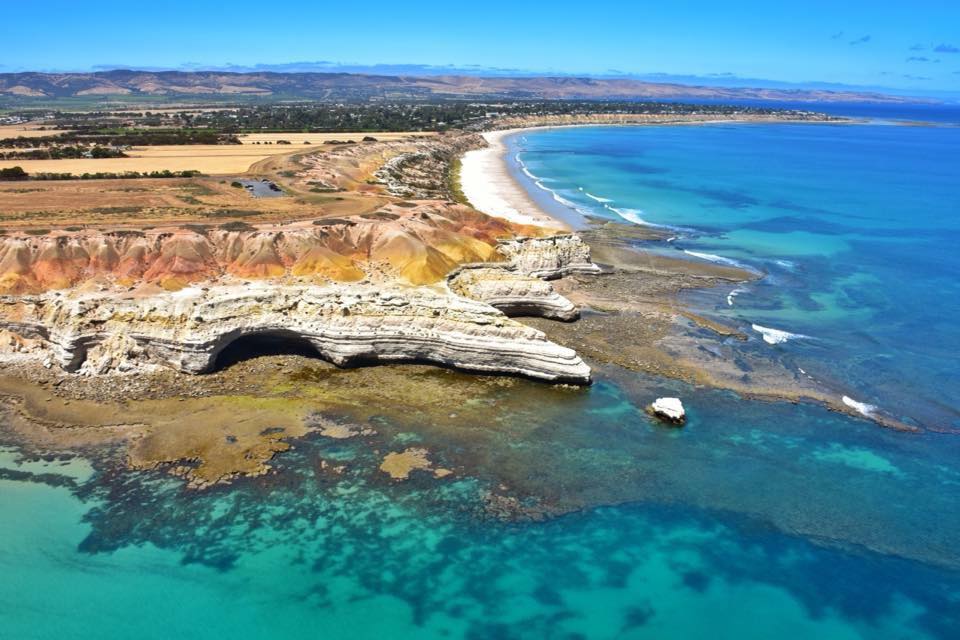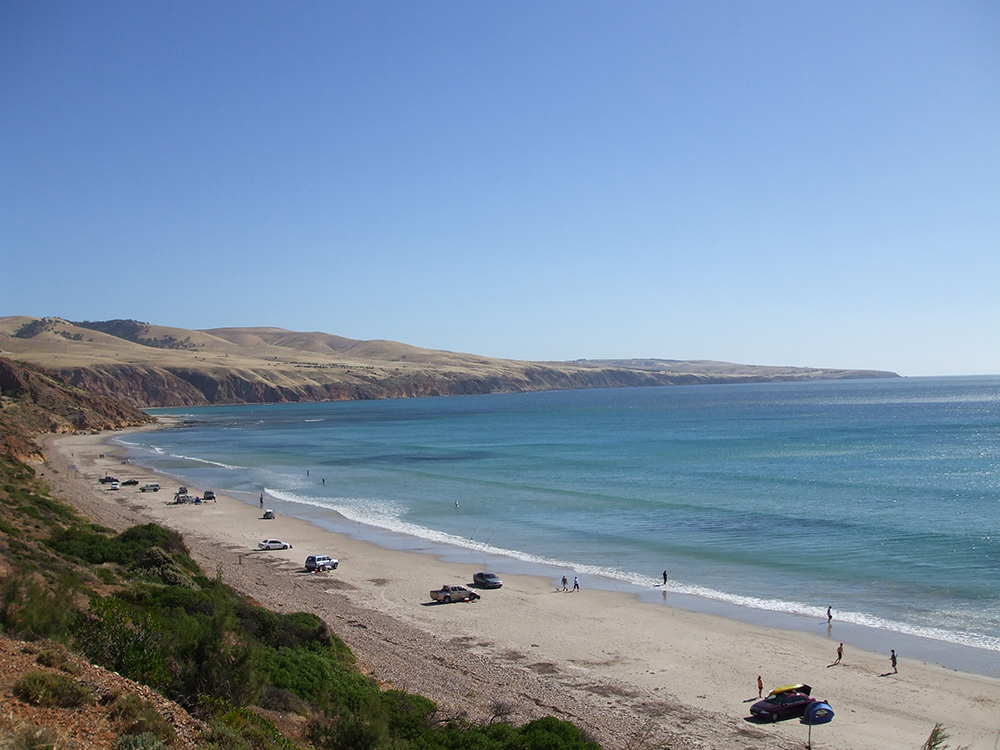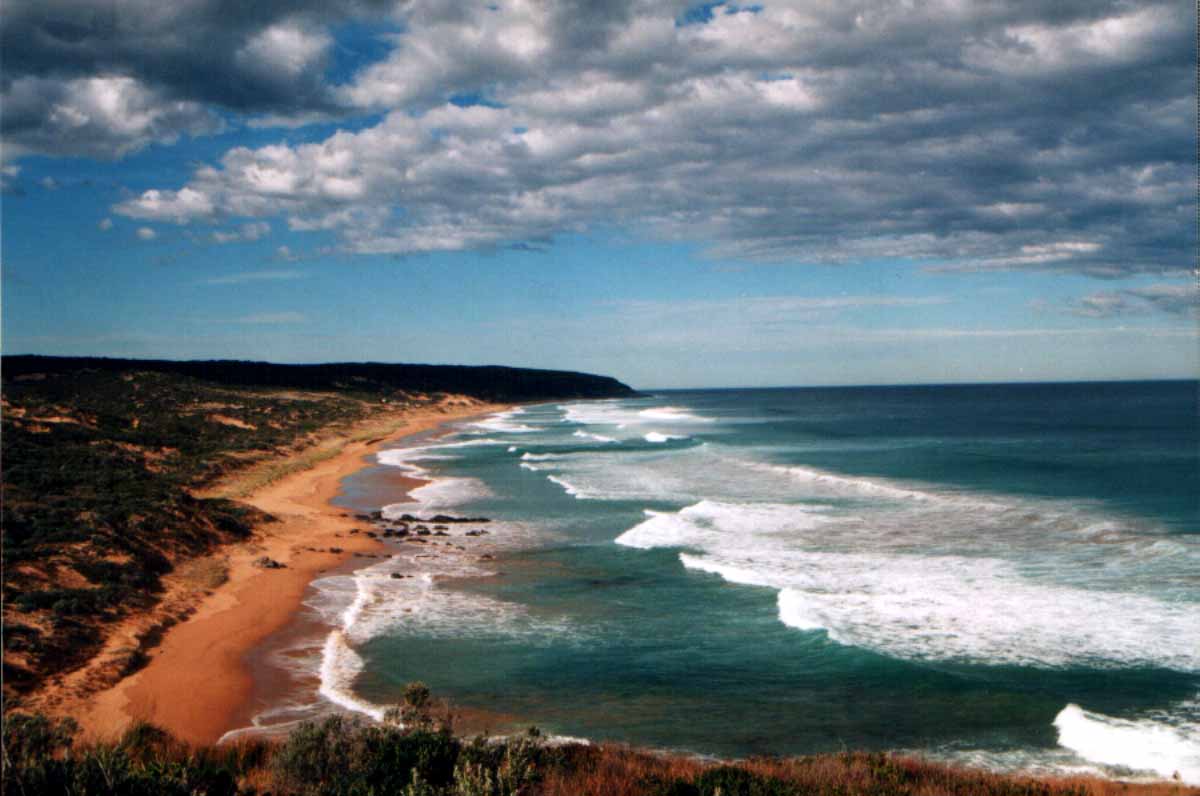Coastal Creationism - Part 10: Why Adelaide's surf coasts are so different
Welcome to the Iatest Coastal Creationism, the series that looks at the geological forces that have created our coastlines. Till now, we've been examining particular phenomena such as how the ideal reef shape is formed, or why some stretches of coast perform better than others.
From this instalment onwards, the author, Chris Buykx, is going to retract the viewfinder and take a wider scope. As always, he'll describe how coastlines were created but with an emphasis on broader regional dynamics.
To begin with, Chris sets his sights on the coastline south of Adelaide - from the Mid Coast through to the Coorong.

Gull Rock on the Mid Coast (Photo Shane Daw Westpac Lifesaver Rescue Helicopter service)
South Australia is probably not at the top of most surfers lists as a destination, however the great diversity in coast and waves does give us some helpful insights in to processes at work in the surf zone. In this article I am specifically looking at the coasts south and east of Adelaide because there is a lot happening geologically. It is interesting because there have been a number of important geological events at regular intervals for over 600 million years. Significantly, some of those processes are still happening today.
Most readers would be aware that Australia is a geologically ancient continent, with some basement rocks in WA over 3,500 million years old. Some of the land surfaces in the west have gone over 200 million years with only weathering and erosion. The south and east coasts of South Australia are interesting because of the unusual combinations of ancient basements rocks, extensive glaciation when part of Gondwana, and then a long history of tectonic movements and sediments that cover the period that Australia rifted from Antarctica and right through until present day.
The result of this is incredible diversity in geology, coastal geography, and ultimately the shape of the reefs and sand banks. Adelaide surfers know instinctively that the character of the breaks changes massively between the Mid Coast, Kangaroo Island, Victor Harbor, the Coorong, and the Limestone Coast. This change in breaks is not just a function of aspect and exposure to swell, its also about rocks and sediments that make up the coast. In this article we'll look at each region as we head south from Adelaide and examine the factors at work.
1. The Mid Coast (O’Sullivans Beach to Sellicks Beach):
Many surfers have a love/hate relationship with the Mid. They curse its lack of exposure to swell, but love its abundant peeling reef breaks. It seems criminal that such great reefs are blocked from much of the Southern Ocean swell.
The obvious question is why there are so many decent surfing reefs here but not further south. Well, i'ts a long story that goes back to the time Antarctica and Australia split up. The Southern Ocean was the last major continental rift in the break up of Gondwana. The rift opened like a zipper from west to east, with blocks being uplifted and down-warped with massive faults between the blocks. One block subsided about 45 million years ago as the ocean opened and the resulting basin slowly filled with a variety of shallow marine sediments. The thinly bedded silt stones, fossiliferous limestones and sandstones formed the Willunga Embayment, part of the St Vincents Basin.
Importantly, these bedded rocks have been slightly tilted and now form the gently dipping thinly bedded outcrops discussed in Coastal Creationism 4. These beds erode to form ramps and convex lozenges that are perfect for turning long-lined swell into peeling walls. Interestingly, these same rocks also form the rich, limey soils of the McLaren Vale and some of Australia’s finest wines.

The view south from Sellicks Beach showing the escarpment that marks the end of the Mid Coast
2. Southern Fleurieu Peninsula and Kangaroo Island:
The coast, landscape, and geology abruptly change south of Sellicks Beach, at the fault scarp created by the uplift of the southern end of the Mt Lofty ranges. From the escarpment to Cape Jervis, including much of Kangaroo Island, we see the older folded and hard rocks. These rocks are around 520 million years old and part of the Adelaide Geosyncline that makes up the Mt Lofty and Flinders Ranges. They are generally steeply folded and include very hard beds of metamorphosed sandstones and some granite intrusions. The result is extremely blocky outcrops that erode in to chaotic, steep and chunky reefs that don't tend to form good surfing reefs. The are a few locations on the south coast of Kangaroo Island where the folded rocks dip at a shallow angles toward the ocean, creating rare lozenges and ramps that turn into serious reef breaks on their day.
3. Victor Harbor Region:
Many surfers have pondered the stark contrast between Waitpinga and Middleton, only 20 km to the north-east. Waits and Parsons are steep, powerful beach breaks that often barrel and form regular rips and banks. The sand is blonde and coarse and the ocean waters clean and green. Whereas Middleton is a broad, gently sloping beach of grey sand lapped by similarly grey, silt-laden waters. Despite the tourism hype that Middleton is South Australia’s home of surfing, the waves are unusual compared to almost all other Australian beaches and can be underwhelming for those expecting some power. The broad flat and virtually featureless beach does not readily form rips and gutters. Waves typically form spilling peaks that roll slowly across a broad surf zone. Steep wave faces are rare and short-lived, barrels unheard of.
The contrast between Middleton and Waitpinga could not be more extreme. So what's going on? As discussed in the last Coastal Creationism, it's all about sediment supply. The beaches of Middleton are the western end of the mighty Murray River mouth. Despite the Murray waters rarely reaching the sea, the river has dumped incredible amounts of sand and silt over the eons. The relatively high wave energy of the Southern Ocean is constantly reworking these sediments and has laid them out in a broadly sloping beach that extends for over a 180km of the Younghusband Peninsula and Coorong. More significantly, a gently sloping ramp of sediment extends a great distance and depth offshore of the beach. At Day Street it is over 10.5km offshore before you reach the 30 metre depth contour (isobath). Conversely at Waitpinga and Parsons the beach is derived of coarse quartz sands derived from nearby granite and metamorphic rocks. With relatively limited sediment supply, the beaches are comparatively narrow and exceptionally steep, despite a similar wave climate. Just looking at the waves you get the feeling they are coming out of deep water and detonating on a steep beach. Unsurprisingly it's only 1 kilometre from the beach to the 30 metre isobath.

Waitpinga Beach. Note the short, steep beach profile characteristic of this stretch of coastline
It has been suggested that the deep channel of the Backstairs Passage between Cape Jervis and Kangaroo Island was carved by glacial action. If you go back 250 million years ago to the Permian period, Australia was still part of Gondwana and the land was over 70 degrees south. The planet was gripped by multiple ice ages and ice sheets spread across the land. There is certainly evidence of glaciation with some basement rocks carved with deep grooves and glacial sediments deposited in numerous locations. In fact the granite outcrops at Knights were passed over by Permian glaciers and sediments in from the glacial lakes can be found in the cliffs. However this has little to do with the incredible wedge that rebounds of the cliffs.
The Encounter Bay granites are heavily jointed and intruded by dykes. This joints are oriented SSW/NNE and hence the blocky granite forms a ramping wall perpendicular to the swell, resulting in some wave energy rebounding as a wedge travelling at an oblique angle to the main swell. The result is plenty of amusement for the bodyboarders and their orthopaedic surgeons.
4. The Coorong and the Limestone Coast:
From Middleton to Cape Jaffa the entire coast is relatively young, comprised of sediments laid down in the last few hundred thousand years. We have already discussed how these recent ice ages resulted in much lower sea levels and the coast extending out toward the continental shelf. During these periods huge amounts of sediments were laid across the region. When sea levels rose, these sediments were pushed up in to beach barriers and parallel dune ridges. The Younghusband Peninsula is a beach-dune barrier created when the sea rose to its current high levels, stabilising around 6,000 years ago. Behind it is the Coorong, a back barrier lagoon created between current dunes and the dunes formed at the old shoreline approximately 125,000 years ago. The sands are derived mainly from the sediments brought down the rivers. That is, they are quartz, silt and clay, and not readily cemented into rocks unless buried for millions of years.
The same process has been replicated on the Limestone Coast, forming many ridges parallel to the coast. However the coastal ridges are a recent and minor feature. The Limestone Coast is dominated by a broad and thick sequence of shallow marine limestones that were laid down between 15 and 38 million years ago, as the Southern Ocean opened. The limestones are often thickly bedded (>1m thick), as a result the resulting reefs tend to be blocky and a bit random, lacking the smoothly convex ramps found in other geologies. There are a few decent reefs and these occur where thinner beds occur between harder beds of limestone at an appropriate depth in the surf zone so as to form a decent ramp.
Coastal Creationsim is an ongoing series written by Chris Buykx. Chris is a geologist, traveller and lifelong surfer. Specialising in eco-tourism, his passion is interpreting nature and the environment. Chris is a resident of Sydney’s Northern Beaches.

Comments
Yep beautiful reefs! It made Rodney Fox famous!
Yeah there are a few set ups on the lime stone coast... Good ones..... It's the wind that's the worry down here.....
This is true SD but for the amount of reef lining the coast from Robe to the border. The amount of quality reefs is dismal compared to what could be..
Yes, Craig.... You keep telling them that..... You're a good man, Craig.... A good man indeed..... ;)
It's Day Avenue , not Day Street! Check the sign for yourself next time you are down there.
But who calls it Day Avenue? No one I know..
Yeah, and now they're deciding to call it Miami.
I thought the Middleton holy triumvirate was Quality Street, Wotstha Point & Gay Bay?
Groan...
ssshhh - don't give away the 'day avenue' secret. Its called 'day street' to throw non-locals off the scent, sending them yonder to the non-world class breaks in the area whilst us in the know can score the spitting mind bending time-tunnels day avenue produces with an almost frightening regularity
Anyone who considers Adelaide's mid coast a "surf coast" needs to be checked for LSD... Spent on and off 5 or so years in Adelaide..... Novelty Coast.. Not surf coast..
Perhaps we could do a special on redcliffe and South Bribie next? lol
That's the problem, it's been called Day Street ever since the Bob Bruce surf reports used to be on the radio back in the 1970's - these anomalies just get passed on from generation to generation without challenge. Bob got it wrong then and it's been wrong ever since. It’s a bit like the Ode to the Fallen spoken on Anzac day - the phrase "nor the years condemn" does not make any sense when you think about it. Condemn what? I'm sure Laurie Binyon originally wrote "nor the years contemn" which makes perfect sense for 19th century English poetry - the passing years did not treat the dead soldiers with contempt. People just got lazy and kept saying condemn because hardly anybody cares about 19th century poetry. Anyway I bet you will now check the street sign next time you go down along surfer's parade, and its even correct on google earth!
The Mid has the set-ups and no swell, down south has the swell and no set-ups, the South-East has swell and constant southerlies, Yorkes has perhaps three good waves, the lower West Coast (Lincoln to Elliston) has about three good waves, a heap of almost waves and straight beachies along a 160km stretch of coast (think about how many good spots you’d find along a 160km-long stretch of southern NSW, south-west WA or northern NSW-southern QLD). Things get a bit better around Streaky, and then there’s Cactus, which everyone pretends is a secret desert oasis but is actually chock full of frothing surfers. Whole state’s a hoax.
Haha - Nailed it!
Yes there are good waves, few and far between though and not really consistent.
I would say though, down south doesn't really have the swell, it's actually quite sheltered. Very rarely does it get to 6ft+ there. Such a disappointingly average coastline wave wise.
The one thing SA does have though is lack of crowds (except the mid and south coast). It's still a long way to travel for East coast crew, and there's plenty of opportunities for to come home empty handed.
Bahahahahahaha.....
The coastal path from Marino rocks to Hallett cove is pretty cool, where the regions funky geology is exposed there are some information boards which explain what's what. Good little training run as well if you are that way out, then you can compensate for the exercise with beer and wood fired pizza at the hallet cove end.
Hey Chris, loving the series, thanks for sharing. Me and the family are on the last leg of a trip around the country and have had the benefit of reading some of these articles as we surf the areas to which they refer. And on our way to south oz soon... Do you plan on publishing this series as a pocket travel guide and/or coffee table book? Would be keen to pick up copies if this was the case...
Can you imagine some of the mids reefs at 6-8 foot?
Yeah, it would be just one big closeout.
The reefs hardly handle 4-5ft as it is.
Enjoy the travels Simplefin. No plans for any books because when we travelled we kept most things electronic. Hema Maps, WikiCamps are the best apps ever - don't need much else after that.
We wrote a blog with plenty of video edits on trip. Mainly to keep the friends and family informed. Feel free to check it out, I am sure you had many similar experiences.
http://anticlockwiseaust.blogspot.com.au
Yeah wikicamps is great. I checked out a few of your clips on the blog site. There are definitely some recognisable scenes among them. And some quality accompanying tunes. I hadn't thought to take much footage during the trip, so will catch some over the last 4000kms... Looks like you and the family had an unreal time and had some great experiences, especially up close with wildlife. Took the short way round too eh? Looking forward to the next installment... Peas
35,000 km doesn't feel like a long way anymore. At least 15,000 of that on dirt. Left the black top at Cape Trib and didn't really do much highway driving again until we got got to Broome 2 1/2 months later.
Having flashbacks to the trip now, time to get back on the road. Gonna take the kids and the camper down the coast this weekend and see what swell TC Winston delivers
Spent some time around sellicks about fifteen years ago. no waves when i was there but jeeze it looked like it had some potential. shark factor felt about 15/10.......
South Australia is such an awesome place, with the right attitude and the desire to enjoy the area, rather than exploit it for your own personal success/ gain. you never know where you might end up or who you might meet.
One night, we headed to a friends place for a birthday.Turns out half the people there were older surfers from the cactus area, back in town to celebrate their friend's birthday. A fun night was had by all.
Also anyone pissing on about the lack of waves and conditions really needs to check there Farmers union iced coffee cause that shit is half full not empty.
Lets revive this thread tell me your best mid/ south coast surf memories
COVID killed the Mid in March 2020 and it hasn't been the same since.
I saw an overhead wave at Seaford reef in 1970 that held up.
a side note to any surfers making the trip to waits and parsons of late (spring time) heaps of dead shingle backs, bearded dragons and snakes that have been driven over on the way out too or in. Preserve them if you can. Happy surfing